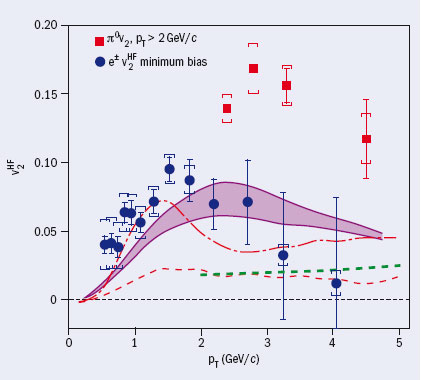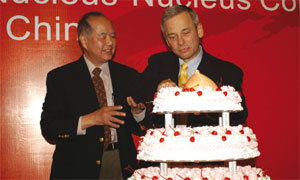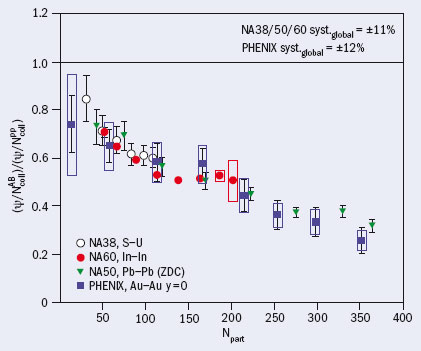The latest experimental results from the heavy-ion programmes at RHIC and CERN’s SPS were the focus of attention at QM2006 in Shanghai. For the first time there were discussions about attempts to connect these data with string theory.
The field of ultra-relativistic heavy-ion collisions held its 19th international quark-matter conference, QM2006, in Shanghai on 14–20 November 2006. More than 600 physicists discussed the latest experimental and theoretical advances in the study of quantum chromodynamics (QCD) at extreme values of temperature, density and low parton fractional momentum (“low-x”).

The wealth of data from the six years of operation of the RHIC collider at Brookhaven, together with that from the fixed-target programme at CERN, is leading to a developing paradigm of the matter produced in high-energy nucleus–nucleus collisions as a “perfect liquid” with negligible viscosity. Far from the ideal parton-gas limit, the lattice QCD calculations for several quantities, such as the equation of state and the quarkonia spectral functions, reveal a non-trivial structure up to temperatures three times higher than the critical QCD temperature – the region that experiments are studying. The current theoretical and experimental efforts centre on characterizing in detail the unanticipated properties of this strongly interacting medium.
Strings and the perfect fluid
One of the most important indications of the formation of thermalized collective QCD matter in heavy-ion collisions is the observation of hydrodynamic flow fields in the form of large anisotropies in the final particle yields with respect to the reaction plane. If the medium expands collectively, the pressure gradients present in non-central collisions – with an initial lens-shaped overlap area – result in momentum anisotropies in the final state. Fluid-dynamics calculations indicate that such gradients must develop very early in the collision, during the high-density partonic phase, in order to reproduce the strong “elliptic flow” seen in the data.

Two new experimental results presented at the conference supported this theoretical expectation. The PHOBOS and STAR collaborations at RHIC have observed large dynamical fluctuations of the elliptic-flow strength, which are fully compatible with those expected from event-by-event variations in the initial collision geometry alone. These results confirm that the strength of the collective flow is driven by the initial spatial anisotropy of the medium. The PHENIX collaboration presented data on the azimuthal anisotropy of electrons coming from the decay of charm and beauty mesons (figure 1). They have observed momentum anisotropies as large as 10%, indicating that charm quarks interact collectively and participate in the common flow of the medium. Both results clearly suggest a robust hydrodynamical response developing during the early partonic phase of the reaction.
On the theory side, progress was reported on hydrodynamical approaches including computationally expensive descriptions of the full three-dimensional evolution of the plasma, as well as, for the first time, viscosity corrections. These calculations indicate that the dimensionless viscosity-to-entropy-density ratio, η/s, has to be very small in order to reproduce the liquid-like properties seen in the data. If the viscosity is negligibly small then the produced medium is the most perfect fluid ever observed, in striking contrast with the ideal-gas behaviour at high temperatures that asymptotic freedom predicts. Determining the transport properties of such a medium in the region not far from the critical temperature is, however, a difficult task: perturbative expansions break down in this region while finite-temperature lattice techniques are not well adapted for studying real-time quantities.
Techniques developed in the context of string theory, where strong coupling regimes are accessible to computation, can help to circumvent this difficulty. The meeting in Shanghai heard of new approaches that make use of the correspondence between anti-de-Sitter (AdS) and conformal-field theories (CFT) to estimate the properties of strongly coupled systems in N = 4 super-symmetric Yang–Mills theory from calculations in dual weakly coupled gravity. The somewhat controversial hope is that these theories, though different from QCD, capture the relevant dynamics in the range of interest for phenomenology at RHIC. One of the first observables computed by these methods is the η/s ratio, which is conjectured to exhibit a universal lower bound of 1/4π.

The conference also reviewed results on the heavy-quark diffusion coefficient, the jet-quenching parameter, and photon and dilepton emission rates. The application of AdS/CFT techniques, which the field has received with both enthusiasm and criticism, is nonetheless providing new insight into dynamical properties of strongly interacting systems that cannot be directly treated by either perturbation theory or lattice methods. At the same time this approach is opening novel directions for phenomenological studies and experimental searches.
Jet quenching
The study of hadron spectra at high-transverse momentum in heavy-ion collisions – the apparent modifications of which are generically known as jet quenching – was again one of the main conference topics. Speakers from experiments at both RHIC and CERN’s SPS presented new results on inclusive high-pT hadron suppression and two- and three-particle correlations between a leading trigger particle and the associated hadrons. Two clear experimental facts summarize the findings: the strong suppression of the yields of leading-hadrons indicates that fast quarks and gluons lose a sizeable amount of energy when traversing dense matter; and the two- and three-particle correlations studies indicate that this energy reappears as softer particles far from the initial parton direction both in azimuth and rapidity space.
When the transverse momentum of the trigger and the associated particles are both similar and of the order of a few giga-electron-volts, the two-particle-correlation signal around the direction opposite to the trigger particle presents a dip in central collisions, in striking contrast with the typical Gaussian-like shape observed in proton–proton and deuteron–gold collisions (figure 2). The three-particle-correlation data indicate a cone-like emission rather than a deflected jet topology. One proposal is that conical structures result from shock waves or Cherenkov radiation produced by highly energetic partons traversing the medium. Such observations could thus help to constrain the value of the speed of sound or the dielectric constant of the plasma. A more conservative explanation proposes one-gluon exclusive bremsstrahlung radiation at the origin of the enhanced “Mercedes-like” topologies that experiments observe. The differential studies of the transverse-momentum and the centrality dependencies presented at the conference further constrain the models.
Interesting intrajet correlations also appear in the near side, that is at angles in the trigger particle hemisphere. Owing to the trigger bias the near-side signal is sensitive to interactions that originate close to the surface of the hot dense fireball, while the opposite-side particle production reflects the most probable longer path through this medium. The data from the STAR collaboration (up to pTtrig = 9 GeV/c) show that, although the near-side azimuthal correlations remain basically unchanged from proton–proton to central gold–gold collisions, the pseudo-rapidity distribution is substantially broadened in the gold–gold case and presents a ridge structure above which an almost unaffected Gaussian shape appears. The dynamical origin of this effect is not yet understood but, interestingly, it indicates a coupling of the longitudinally expanding underlying event with the jet development.

With increased integrated luminosities, heavy-quark probes are becoming more and more important at RHIC. The latest PHENIX data indicate a large suppression of decay electrons from high-pT charm and beauty mesons. The amount of suppression is very similar to that of the light-quark mesons, which is difficult to accommodate in most jet-quenching models since QCD distinctly predicts a lower gluon radiation probability for heavy-quarks compared with massless quarks or gluons.
There are also new results for direct photon production in gold–gold collisions up to transverse momenta of 20 GeV/c. Comparison of the gold–gold and proton–proton yields indicates that the QCD factorization theorem also holds for hard scatterings with heavy ions. The quality of the data is such that small deviations from the proton–proton reference can be traced back to isospin corrections and nuclear modifications of the parton distribution function in the nucleus. With improved statistics it will certainly be possible to use such data in global-fit analyses to constrain the nuclear parton distributions.
Last but not least, the conference saw the first measurements of direct photons emitted back-to-back with high-pT hadrons. With reduced uncertainties such correlations will provide an important calibrated measure of the energy lost by the original parton.
J/ψ melting and lattice QCD
The suppression of charmonium bound states, in particular the J/ψ, was proposed 20 years ago as a smoking-gun signature for quark–gluon plasma formation, and this is still the experimental observable that offers the most direct connection with lattice QCD. The first high-statistics results from RHIC were presented in Shanghai. Surprisingly, they show that the amount of suppression is almost identical to that found at the SPS (figure 3). The medium created at RHIC is expected to be much denser and hotter than that at the SPS and most models predicted a stronger depletion.
A natural explanation of the similarity of the suppression at the two energies (√SNN = 17 and 200 GeV) is put forward by recent lattice data that indicate that the J/ψ (but not the χc and ψ’) survives up to temperatures twice the critical one. The increase in the temperature from the SPS to RHIC would not be enough to dissolve the J/ψ, which is then only indirectly suppressed due to the lack of feed-down contributions from the dissolved χc and ψ’ states. Alternative explanations point out that the recombination of charm and anticharm quarks in the thermal bath (up to 10 charm–anticharm pairs are produced in central gold–gold collisions at RHIC) could compensate almost exactly for the additional suppression. The influence of initial-state effects, those present already in proton–nucleus collisions, are not yet completely settled. More proton–nucleus (at the SPS) and deuteron–gold (at RHIC) reference data, as well as the study of different charmonium states in gold–gold, will be needed to unravel the origin of the suppressed J/ψ yields.
Towards the LHC
The emerging picture in ultra-relativistic heavy-ion collisions is that of the formation of a strongly interacting medium with negligibly small viscosity – a perfect liquid – and with energy densities as high as 30 GeV/fm3. These characteristics emerge from the ideal hydrodynamics description of collective elliptic flow, and the large energy loss suffered by energetic quarks and gluons traversing the system respectively. The detailed study of the transport properties of this medium and the potential observation of the anticipated weakly interacting quark–gluon plasma will require key measurements in lead–lead collisions at 5.5 TeV at the LHC. The higher initial temperatures, the greater duration of the quark–gluon plasma phase and the much more abundant production of hard probes expected at the LHC are likely to result in indisputable probes of the deconfined medium that depend much less on details of the later hadronic phase.
A whole morning session at the conference looked at “Heavy-Ion Physics in the Next 10 Years”. The imminence of the LHC start-up – with an active nucleus–nucleus programme being developed by the ALICE, CMS and ATLAS collaborations – guarantees an exciting future for the physics of high-density QCD.







